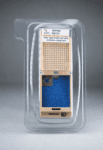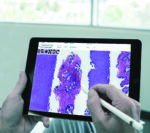Digital pathology has been around for years and on the radar of many pathologists, clinicians, and lab workers. However, many still question what it is, if it’s viable, and how it can work for their specific situation. Digital pathology has made many advancements over the past several years, with companies emerging to simplify digital pathology and provide quality patient care. When utilized correctly, digital pathology is viable and beneficial and is the future of cancer treatment.
What is Digital Pathology?
Digital pathology is the process of analyzing, storing, and sharing pathology image information digitally. Tissue samples are processed, sectioned, and placed on glass slides, then scanned to be stored in a digital database where they are shared and interpreted/diagnosed digitally and remotely.
How has Digital Pathology Evolved?
Digital pathology has been infamous for needing expensive, space-occupying equipment and complex integrations, so many labs avoided it. However, through advancements in technology, digitizing slides has become practical. Now, scanners are smaller and faster, and companies like Lumea have created digital software that integrates various requisite components into a single device, like a tablet. Also, companies such as Deep Bio and Aira Matrix have developed integrated AI designed to assist in analyzing and diagnosing digitized tissues.

Third-party AI vendors integrate with Lumea on the digital platform.
What are the Benefits of Digital Pathology?
Digital pathology allows for more accessible information sharing, case distribution, consultation, and education. Newer developments promise increased efficiency, error reduction, diagnostic assistance, automated Quality Assurance, optimized molecular testing, and even replacement for various current special testing.
Why is digitizing and creating a high-quality image of tissue beneficial? Once digitized, the images can be distributed anywhere immediately and are available for various specialized analytics, some using artificial intelligence (AI). However, there is a possibility for delay while waiting for slides to be scanned and when navigating the digitized image. Because of this, there must be more pros than cons to make digital pathology viable. Recent technology has made this possible. Lumea has added various devices and software enhancements that more than compensate for the additional time of digitizing slides, making it beneficial for pathologists, clinicians, labs, and, most importantly, patients. Previously, it would have taken weeks for patients to receive results from a biopsy, now they can receive their diagnosis and second opinions faster, as well as track the progress of their results with their clinician.
Make Digital Pathology Work For You
With solutions that start at the time of the biopsy, digital pathology is valuable and applicable to the clinic, lab, and pathology suite.
In the Clinic
As in the lab, most digital pathology does not involve the patient clinics; however, Lumea’s technology actually begins when the tissue sample is taken, using tools to improve the chain of custody and retain tissue orientation. While these tools are utilized at the time of the biopsy, the benefits continue between the lab and clinic with increased efficiency, error reduction via reduced tissue transfer steps, and preservation of tissue integrity and orientation that allow for additional clinically relevant information to be conveyed to the clinician. Additionally, Lumea’s software helps ensure that the correct additional testing (e.g., molecular testing) is done on every patient when appropriate. Clinicians can also readily order second opinions directly from the system.

RFID tracking is available at the time of the biopsy with BxView®
Also, Lumea offers RFID tracking, which begins in the clinic. Now, the clinic has visibility into the progress of pathology, the histology, and the biopsy. This enables the clinic to take the guesswork out of the waiting process and also equips them with beneficial information for patient communications. The lab can forecast predicted case volumes for the next day and plan accordingly, share this valuable information with the clinic, and clinicians and patients alike have peace of mind knowing the location of samples and when results are available.
In the Lab
Most digital pathology does not directly affect the lab until glass slides are created. Without digital pathology, they would be distributed to pathologists to evaluate under a microscope; however, when employing digital pathology, there is an additional scanning step where a whole slide image is created. Management and storage of the images are also required, in addition to storage of the glass slides and tissue blocks. To improve this process, Lumea has developed tissue-handling devices that require much less technical time, retain tissue orientation, reduce tissue fragmentation, and even increase tissue yield on the slide. Ann Marzuco, a histotechnologist, said of Lumea in the lab, “It’s really revolutionized what we’ve done in the lab… I would never go back.” (Read the full story here). New AI technology is also available for use in the lab, with Lumea’s grossing camera. This product reduces grossing time and allows AI to measure biopsy fragments, simplifying and improving lab processes.

Visual of the BxBoard®
In the Pathology Suite
Pathologists are no longer tied to one location, as they can view the scanned slide from a computer or tablet of their choosing. Previously, pathologists would need to wait for shipping depending on where they and the samples were located, and samples might be broken in transit. Pathologists can view and annotate each tissue sample using digital software and create notes. These are all stored in one system and are easily shareable. AI software can also analyze tissue samples for a variety of features to aid the pathologist in making the correct diagnosis and even which samples are best for further testing. Digital pathology also allows for unique viewing options like the simultaneous side-by-side viewing of multiple sections and even automated quality assurance testing (Lumea is developing both).


Other digital pathology solutions are still tied to one location involving large monitors. With Lumea, there are no geological constraints, and can be accessed on a tablet.
Advancing Digital Pathology
As mentioned above, Lumea has the latest technology in digital pathology and continually strives to improve diagnostic processes by creating new cancer diagnostic tools. Here are several tools that are used in Lumea’s digital pathology:
Tissue Transportation: Lumea has created the BxBoard®, a case that stores separate cores, preserving tissue orientation and integrity while transported.
Tissue Storage: The BxChip® is a proprietary tissue-mimetic device that securely holds tissue samples through processing, embedding, and microtomy. It maintains orientation and allows multiple samples to be segregated and tracked separately by the software, even allowing for annotation-based diagnosis creation. This revolutionary device significantly saves lab time, improves tissue yield, and allows the pathologist to not only save time but also provide additional information to clinicians about previously impossible orientation.

Visual of the BxChip
Grossing Camera: The BxCamera® takes an image of the gross specimen, and AI-enhanced software can detect, count, and measure biopsy fragments. This simplifies and accelerates the grossing process, allowing flexibility for where and when grossing is performed.
Digital pathology is the future of high-quality patient care, but until now, it has been fraught with obstacles that have prevented wide adoption. More clinics, labs, and pathologists can transition to digital pathology with recent innovations in integrating image management, LIS, AI, and various innovative devices. In this new era, digital pathology will help medical professionals provide accurate diagnoses and optimal treatment plans while simplifying the pathology process from clinic to lab to pathologist and back to the patient.

